Expeditions
Expedition 2024 (jointly with CLICCS A1)

1 / 76
Susanne Liebner
Sometimes things go differently than planned. The expedition team is stranded in Ilulissat. A spare part for the helicopter is missing and the weather is too unstable for a helicopter flight. This means there is less time for the upcoming work on Disko Island. Therefore - recharge your batteries first!

2 / 76
UHH/C.Knoblauch
Winter harbor of the fishermen in the ice fjord near Ilulissat

3 / 76
Susanne Liebner
Picturesque sunset over the ocean with a view of the harbor town of Ilulissat.

4 / 76
Susanne Liebner
After 5 days of waiting in Ilulissat - Finally: The sky clears and the helicopter is ready for the last part of the journey from Ilulissat to Qeqertarsuaq.

5 / 76
UHH/C.Knoblauch
The last stage from Ilulissat to Qeqertarsuaq can begin!

6 / 76
Torsten Sachs
Finally arrived at the heliport in Qeqertarsuaq! Now it's time to quickly catch up on 5 days of work!
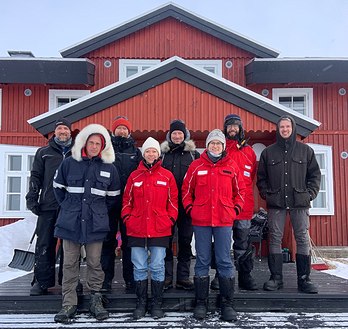
7 / 76
Susanne Liebner
April 2024: The first team of MOMENT and CLICCS-A1 researchers has arrived at the Arctic station.

8 / 76
Susanne Liebner
In winter, we travel to the study area by snowmobile.

9 / 76
UHH/C.Knoblauch
Sledging for grown-ups

10 / 76
Susanne Liebner
Along the snow trails on snowmobiles through Blæsedalen - the valley of the winds.
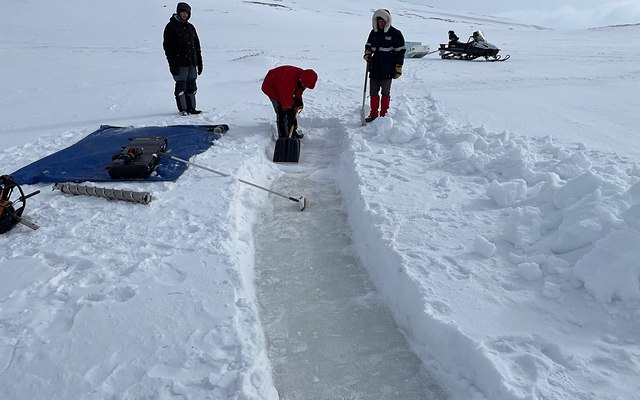
11 / 76
Torsten Sachs
The snow was pushed aside to examine the ice on the lake.
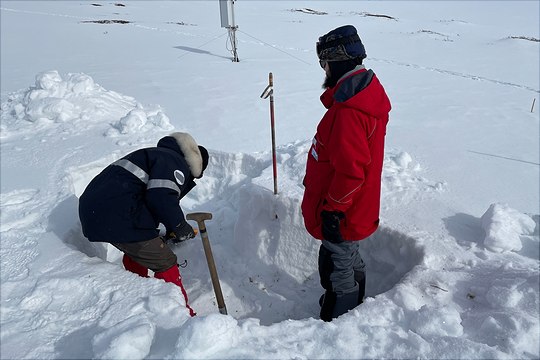
12 / 76
Torsten Sachs
The first step in drilling the soil cores is to remove the snow cover from the soil surface.

13 / 76
Torsten Sachs
Then drilling is carried out diligently, the surface properties are recorded and the coordinates are read in.

14 / 76
Torsten Sachs
Lunchbreak at the expedition site.

15 / 76
UHH/C.Knoblauch
The clothing keeps you dry and warm - even during a lunch break in the snow.

16 / 76
UHH/C.Knoblauch
The expedition team takes frozen soil cores. These are transported to Germany intact and frozen for extensive incubation studies in climate chambers.

17 / 76
UHH/C.Knoblauch
The drilling of frozen soil cores is carried out along the transects using a "SIPRE-corer".
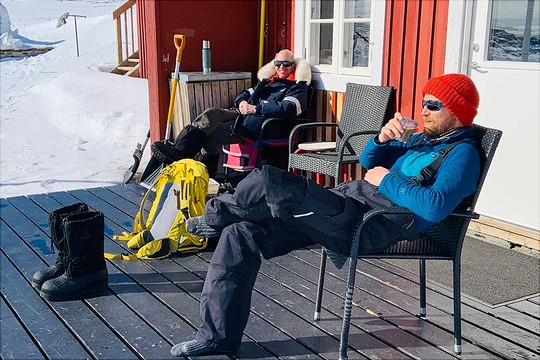
18 / 76
Susanne Liebner
In front of the Arctic Station: closing time - the work for today is done!

19 / 76
UHH/C.Knoblauch
Midnight in Qeqertarsuaq

20 / 76
Torsten Sachs
Teamwork! We did it! Over 20 soil cores were drilled in just 5 days! Luckily the weather played along!

21 / 76
Torsten Sachs
The art of nature! The researchers were rewarded for their hard work with a picturesque landscape!

22 / 76
Susanne Liebner
The study area in white winter beauty!
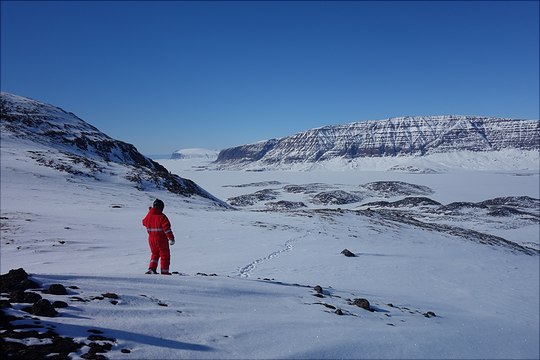
23 / 76
UHH/C.Knoblauch
View from the end of Blæsedalen across the Diskofjord to Kangerluq
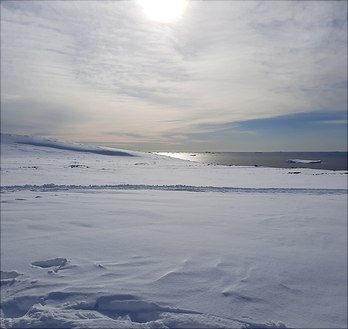
24 / 76
UHH/B.Grabellus
April: View over the snow-covered valley towards the ocean.

25 / 76
UHH/B.Grabellus
A snow-angel is a must.

26 / 76
UHH/B.Grabellus
The soil in Blæsedalen is covered by a layer of ice.
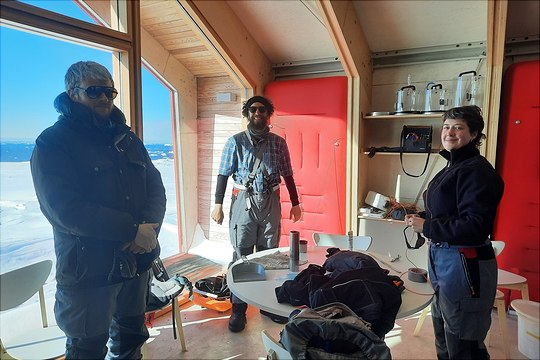
27 / 76
UHH/B.Grabellus
The field equipment is packed up for the day at the “Red Hut” interim storage facility.

28 / 76
UHH/B.Grabellus
The snow is shoveled aside so that the soil can be sampled.

29 / 76
UHH/E.Wilcox
Finished! The frozen soil core is packed.

30 / 76
UHH/E.Wilcox

31 / 76
UHH/B.Grabellus
Arctic Station in snow.

32 / 76
UHH/B.Grabellus

33 / 76
UHH/E.Wilcox
In May, the valley, including the river, is still covered in ice and snow.

34 / 76
UHH/B.Grabellus
Remains of icebergs were washed up on the basalt beach.

35 / 76
UHH/B.Grabellus
End of May: The sun warms the ground. The snow thaws away and exposes the transects. This allows you to take a short breather while the Licor does its work and records the greenhouse gas fluxes on the soil surface.

36 / 76
UHH/E.Wilcox
At the end of May, the first snow melts and the first tips of the shrubs appear.

37 / 76
UHH/B.Grabellus
The snow melts at the end of May.
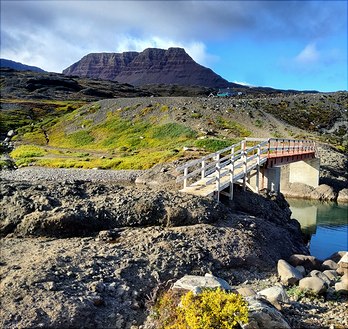
38 / 76
UHH/J.Tamale
We need to cross the Red River over this bridge to get to Blæsedalen, our study area.

39 / 76
UHH/C.Steffens
Crossing the Red River
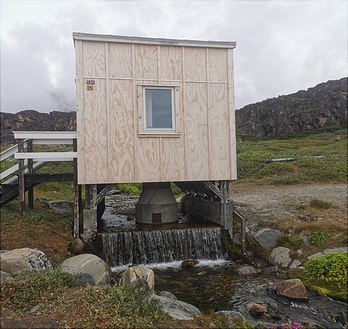
40 / 76
UHH/C.Steffens
This is a source of drinking water for the inhabitants of Qeqertarsuaq. It is located right next to the Arctic station. The locals fill up their water canisters here.

41 / 76
UHH/C.Steffens
The national flower of Greenland - Dwarf Fireweed

42 / 76
UHH/C.Steffens
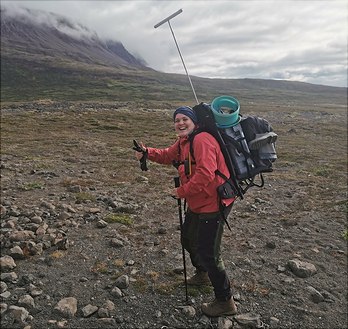
43 / 76
UHH/C.Fiencke
Backpacking licor
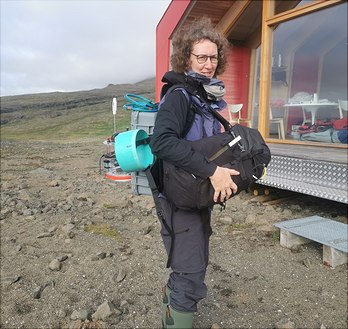
44 / 76
UHH/C.Steffens
... and again

45 / 76
UHH/C.Steffens
... and again

46 / 76
UHH/E.Wilcox
... and one more time

47 / 76
UHH/C.Steffens
Greenhouse gas flux measurements on an Earth Hummock in August.

48 / 76
UHH/C.Steffens
This small intact soil sample with vegetation was taken with a ring sampler. It is now transferred to a jam jar (microcosm) and the change in the methane and nitrous oxide concentration in the microcosm air is recorded on site.

49 / 76
UHH/C.Steffens
The grocery store of Qeqertarsuaq.

50 / 76
UHH/C.Steffens
August: An iceberg directly behind the river outlet

51 / 76
UHH/C.Steffens
In August, the clouds are often very low on the mountains, like here across from the harbor of Qeqertarsuaq.
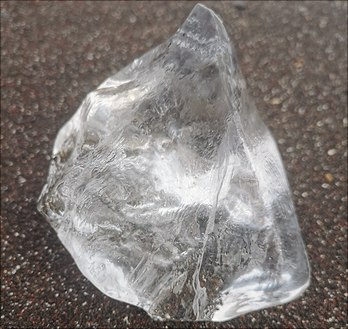
52 / 76
UHH/C.Steffens
Close-up of a small piece of crystal-clear sea ice on the basalt beach

53 / 76
UHH/C.Steffens
The path to transect 3 leads along the Red River at times.

54 / 76
UHH/C.Steffens
View from the Red River towards transect 3 along the terraces.

55 / 76
UHH/C.Steffens
The tasks are well organized. While one person reads off the start time of the measurement, the second person checks the start temperature in the chamber at the same time.

56 / 76
UHH/C.Steffens
Preparations for the capture of methane leaving the soil surface.
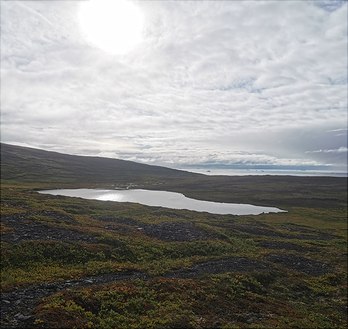
57 / 76
UHH/C.Steffens
August: View from the moraine over the Blæsedalen
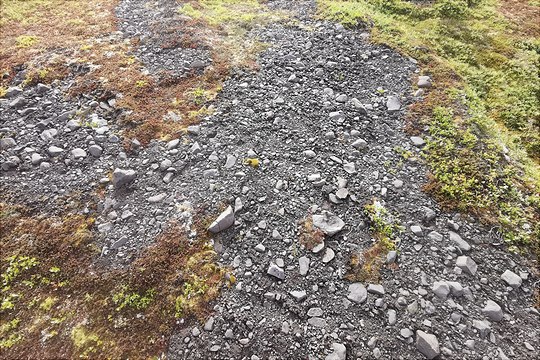
58 / 76
UHH/C.Steffens
A mudboil on the moraine
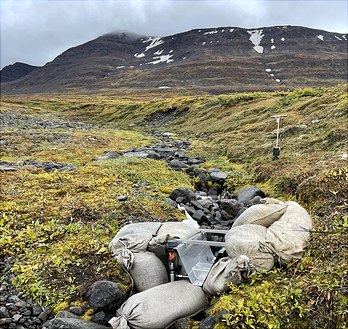
59 / 76
UHH/E.Wilcox
Here, a flume is installed in a small stream to collect the run-off water for analysis.
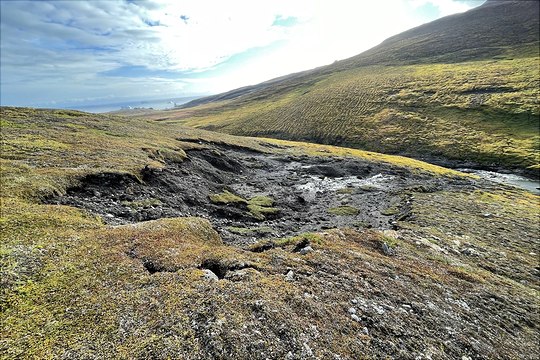
60 / 76
UHH/E.Wilcox
Erosion on the moraine

61 / 76
UHH/E.Wilcox
Solifluction of pattern ground

62 / 76
UHH/C.Steffens
The tundra vegetation begins to take on a colorful autumnal hue as early as the end of August.

63 / 76
UHH/E.Wilcox
View from the Red River over colorful autumnal tundra vegetation towards Arctic Station.

64 / 76
UHH/E.Wilcox
September: Greenhouse gas fluxes are measured at the soil surface on transect 3 north of the moraine.

65 / 76
UHH/J.Tamale
Colorful speckled tundra

66 / 76
UHH/J.Tamale
Beautifully illuminated, meandering river in the September sunshine

67 / 76
UHH/E.Wilcox
September: View from the moraine to the northwest towards the table mountains.

68 / 76
UHH/E.Wilcox
Path along the Red River. There are signs of erosion on the opposite bank.

69 / 76
UHH/J.Tamale
Soil sampling in September

70 / 76
UHH/J.Tamale
September: Soil sampling in the autumnal red tundra vegetation

71 / 76
UHH/J.Tamale
The first soil column for the mesocosm experiments has been drilled!
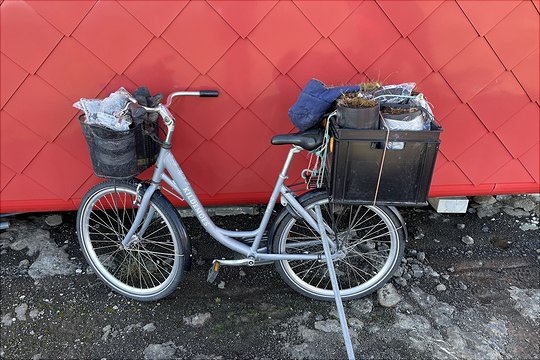
72 / 76
UHH/E.Wilcox
A bicycle is loaded with soil samples and mesocosms. This allows the mesocosms to be transported from the Red Hut to the Arctic Station.

73 / 76
Tino Peplau
A wildlife camera on the upper slope of transect 2 captured the nocturnal visit of an arctic fox.
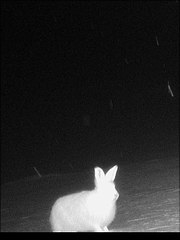
74 / 76
Tino Peplau
An arctic hare also dropped by.

75 / 76
Tino Peplau
... and two canada geese

76 / 76
Tino Peplau
Aurora borealis! Beautiful spectacle in September right on the doorstep of the Arctic Station














































































Expedition 2023 (jointly with CLICCS A1)

1 / 28
UHH/L.Kutzbach
Snow hike to the research site in June 2023
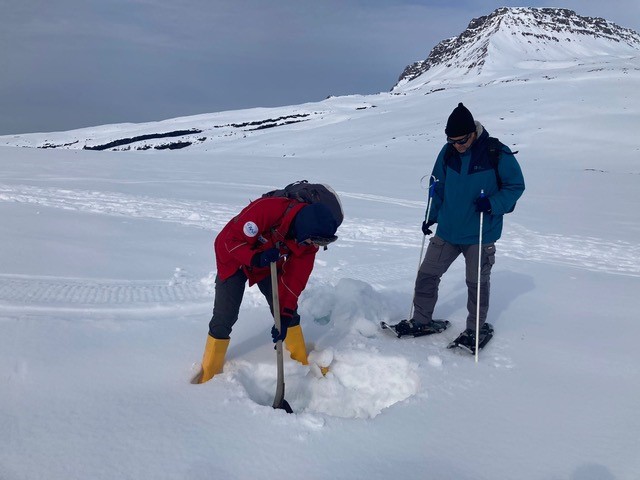
2 / 28
UHH/S.Undeutsch
Let`s see how much snow it is!

3 / 28
UHH/O.Kaufmann
Helicopter transport
On June 19, 2023, the first MOMENT and CLICCS A1 expedition team received the containers with field equipment at the port of Qeqertarsuaq. Afterwards, large parts of the heavy field equipment were transported by helicopter sling transports from the port to the Red Hut or Pjetersson's Moraine.

4 / 28
UHH/O.Kaufmann
View from the coast towards the Arctic Station

5 / 28
UHH/O.Kaufmann
Snowmelt at June 21, 2023 at the coast

6 / 28
UHH/O.Kaufmann
Finally reached the red hut!
Update from Selina Undeutsch on 06/22/2023:
"Today we were at the red hut again. While there is already a decent snowmelt around the village and the Arctic station, the situation is different at the red hut. There are about 80 cm of snow there, also a little fresh snow was fallen yesterday. In addition, under the snow cover there is a layer of ice of about 5 cm thickness.
Due to the positive temperatures, the snow is additionally very heavy and wet and does not carry well. It is recommended to wear snowshoes, otherwise the expedition area is almost impossible to reach."

7 / 28
UHH/O.Kaufmann
Researchers of the Universität Hamburg in front of the red hut

8 / 28
UHH/O.Kaufmann
Snowwalk to the study site
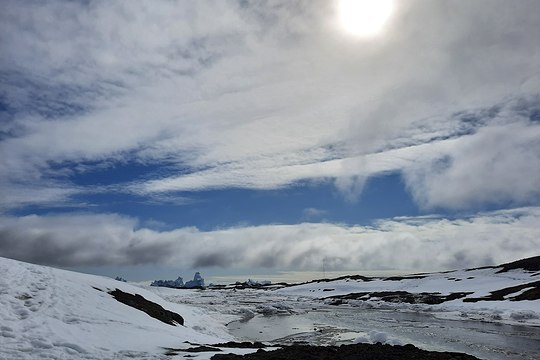
9 / 28
UHH/B.Grabellus
June 2023: Fascinating illumination of the snowy landscape through the clouds.

10 / 28
UHH/B.Grabellus
Contrasts in June 2023
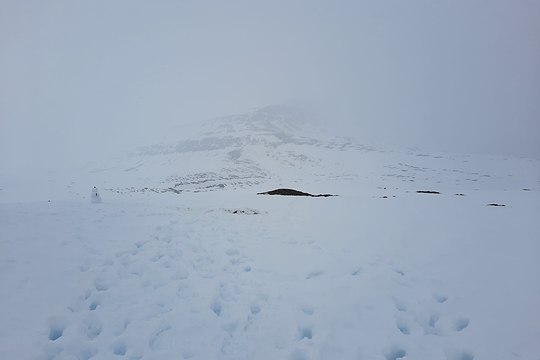
11 / 28
UHH/B.Grabellus
Sometimes contrasts were missing in June 2023.

12 / 28
UHH/B.Grabellus
June 2023: Impression of the snow height

13 / 28
UHH/B.Grabellus
June 2023: a sunny winterday

14 / 28
Susanne Liebner
June 26, 2023: At the ferry port of Ilulissat, Greenland, the next expedition team waits for the ferry to Disko Island. The team consists of scientists from the Universität Hamburg, Leibniz Universität Hannover and the German Research Centre for Geosciences Helmholtz-Zentrum Potsdam.

15 / 28
Tino Peplau
Tino Peplau:
"Right after snow melt, some of our sampling spots are soaked with water, which makes sampling and measurements more challenging."

16 / 28
Tino Peplau
Update from Tino Peplau at July 1st 2023:
"We finally drilled our first soil cores! The cores will be stored frozen and are shipped to Germany for further analyses."

17 / 28
Tino Peplau
Tino Peplau: "With our soil monitoring stations, we will measure redox potential, moisture and temperature of the soil at different spots in the research area."

18 / 28
UHH/L.Birringer
August 2023: Fishing in the free time

19 / 28
UHH/S. Undeutsch
Measuring methane fluxes in August 2023

20 / 28
Jannika Gottuk
September 2023: View over the research site

21 / 28
UHH/C.Fiencke
At the beginning of September, the tundra already shows its most beautiful autumn colors.

22 / 28
UHH/C.Fiencke
September 2023
The tundra landscape is heterogenous on a small spatial scale. Here, we examined how methane fluxes differ between vegetation-free "mudboils" and adjacent zones with tundra vegetation.

23 / 28
UHH/C.Fiencke
September 2023: Short break from carrying the gas flux analyzer - enjoying the scenery

24 / 28
UHH/C.Fiencke
September 2023: A mountain stream meanders through deep notches.

25 / 28
UHH/C.Fiencke
September 2023: Autumn colored tundra
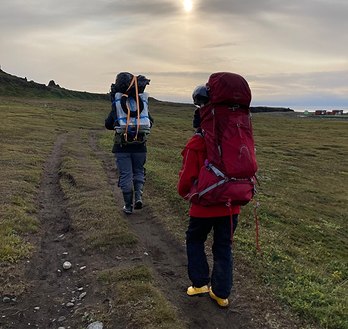
26 / 28
Simone Stünzi
The components of the AWI climate station are carried several kilometers to the destination in the study area.

27 / 28
Jannika Gottuk
September 2023: Researchers from AWI set up the climate station.

28 / 28
Jannika Gottuk
Final settings are made on the climate station.






























